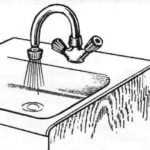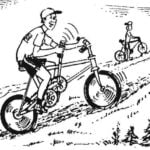 Who does not know kite — bonded multiple reechek a sheet of paper with a long tail from a bast! But few know that this seemingly only entertaining children’s toy has a long and interesting history.
Who does not know kite — bonded multiple reechek a sheet of paper with a long tail from a bast! But few know that this seemingly only entertaining children’s toy has a long and interesting history.
In the manuscript of the early seventeenth century says that in the year 907 during the siege of Constantinople (Tsargrad) Prince Oleg “stvarima Coca and people armed with paper and pozadini and put on the air at deg. When gray (Greeks) and obamaca and obamaca God a tribute to figure out and exits all Russian cities”. This documentary evidence about the first use of kites in military Affairs.
In 1749 the kite began to serve science: the Englishman Wilson ka raised the thermometer and measured the temperature at the height of Cumulus clouds, quickly dangling a thermometer on a land with “postman”.
Famous American scientist Benjamin Franklin in April 1763, made his famous experiment, which explained the electric lightning using a kite.
The first flight of the person in the snake was implemented in 1825. Did the English scientist George Pocock, having a few tens of meters his daughter Martha.
In 1902 the cruiser “Lieutenant Ilyin” conducted successful experiments to raise the observer to a height of 300 m with a train of kites “type Hargrave”.
A year later, the English Aviator Samuel Cody crossed the English channel that separates England from France, on the boat, which was towed by a kite.
Kite played a major role in the creation of the first models of the aircraft, in particular of a biplane. So, Alexander Mozhaysky in 1873 was raised on the kite, towed triple horses. L a Frenchman, Clement Ader, one of the first spent testing before building his car, “Eola”, launched the kite, which had the shape of bat wings, surviving his plane.

Form biplane wing glider was borrowed by American O. Canuto, and then the Wright brothers at the Aussie box-snake L. Hargrave created in 1392.
In 1931 the all-Union competition of model airplanes was held in Moscow rise to a height of 10-15 m of some participants by train from kites, model aircraft built by Kyiv.
During the Great Patriotic war with kites dropping leaflets over the positions of the Nazis.
In 50-ies model airplanes from the Saratov Palace of pioneers under the leadership of D. F. Grigorenko created a sample kite, which was successfully used during the Antarctic expedition of the USSR Academy of Sciences to study the lower atmospheric layers.
In the US, in Boston, the city Department of parks every year arranges kite festival — a competition for the best design of the kite. This tradition is explained by the fact that here in 1706 Benjamin Franklin was born, who used the serpent to open the nature of lightning.
Every year since 1963, Poland is national kite festival — competition of youth in the kite-flying of different designs. They takes the plot to 109 thousand students.
Kite flying is an interesting sport activity for students and adults.
Today we give a description snake box rectangular shape.
The design of the snake (Fig. 1) was first proposed in the late nineteenth century Australian scientist Lawrence of Charges. Its basis is formed by four rails of the longitudinal length of 720 mm and a cross section of 8X8 mm and two pairs of frogs. For them it is necessary to procure four rail spacers with a length of 435 mm and a cross section of 8X8 mm. Spars and struts frogs gently round. To do this, handle their edges with a plane, and then a piece of glass and sandpaper.
The slinky snake consists of two bands macalintal paper or tracing paper, glued the edges to the rails of the frame. Good stitched Mylar or plastic film. Just need two sheets with a length of 1330 mm and a width of 300 mm. the Cream is also a need for any glue — carpenter’s, BF-2, BF-4, 20 m harsh threads and 0.5 m of steel wire with a diameter of about 0.5 mm. of paper cut pattern for each of the bands according to the dimensions given in figure 5.
Strips with a width of 10 mm, protruding beyond the outline shown on the drawing a thin line, serve as a seam allowance.
The thin lines at each of the long sides, tuck the thread, after making the loop length of 80 mm every 200 mm there should be five such loops — the number of cut-outs on each long side of the sheet. The ends of the strands from both sides should be 80 mm.
After putting the thread on a strip of fine line and fluff it and glue the seam allowance, join EfE details of the frame and stitched together. In the middle of each ring insert liner two light Reiki-rib cross-section of 5X1 mm. Their purpose is to eliminate longitudinal folds.
The spars should be the same length, straight and smooth. Departing 10 mm from their ends, make a shallow circular groove. Small curves it is necessary to rectify over a weak fire.

The finished parts are carefully sand the paper, all further zakruglenie rasp. Struts frogs should be customized in length. First, using pliers make eight snare wire Ø 0.5 mm according to the dimensions given in figure 4. Secure each thread with glue on the end of the struts to stand on the spars. Adjustment of the length of the struts perform better on the assembled rod. First, take the rings and cut the stitched thread loops so as to form a mustache. Wearing a ring stitched on the uniform of the spars, tie him “whiskers” to the front of the spar at two points. Similarly proceed with the other spars, and then tie on the other hand, the second paper ring. At the same time, cutting the Central thread loop, tie “antennae” and to the ribs on both rings.
Collecting snakes, insert one side of the rack strut. To make it more convenient to just the two of us. Put it on the appropriate rails spacer rails with forks, gently pull the cording and lowering the other ends of the struts and their length, consistently and gradually cut away the left margin. Finally adjust the length of the rods of struts so that the box the snake had no bias. Then ka opposite end, attach the plug threads with glue. The end plugs on each of the spacers locate in the same plane. Then, by inserting a crossbar, get a second pair of parts and also connect them with each other. This is strictly in the middle of one of each pairs of rails-spacers install on the thread with glue) wire clamp through which passes the second adjacent strut (Fig. 3). Now prepare 16 strips of paper of length 90 and a width of 26 mm. These strips cover the spars inside the paper rings. It must be done when the structure is assembled and crosses the set. The serpent is ready.
Now fasten the bridle. It consists of four loops attached to the lower longerons. All the loops are connected in a single node, located against the geometric center of the front wall of the upper ring and at a distance of 250 mm from it. The end of the bridle has a small wooden crutch (Fig. 2).
Snakes run on the solid twine — the guard rails, is wound from a flyer or punk. For flight, choose a public place where there is no radio aerials, trees and electric wires of high voltage.
Snakes can make interesting games. One of them is: run the snake for a given length of a rail in the shortest period of time.
The second game — reset model parachute with “the postman” in a pre-planned goal — round Ø 20 m. figure 7 shows the simple “postman”, the Basis of it is paper tube, put on the guard rails. It glides along the guide rod from steel wire Ø 1 mm. Its front end is made in the form of a ring facing its plane to the axis of the tube. Rear axle rod is a hook, a straight portion which is directed forward and
passes through the holes of the bracket. Between her legs it put on the loop of thread on the lower end of which hangs a parachute. The tube is made of two or three layers of thin and thick paper with a width of 90-100 and a length of 759 mm and is wound on a wooden cylinder Ø18 mm. the First band outside of the coated adhesive, it is applied a second layer of paper and, if necessary, the third. The total thickness of the tube wall must not exceed 1 mm. After the glue dries, trim the tube without removing the cylinder, a fret saw to a length of 70 mm. in addition, do the bottom two short transverse incision with a length of 5 mm for the upper legs of clamps, made of sheet, turning down those foot on the inside of the tube. The bottom fold, making sure that the holes in them were at the same distance from the wall of the tube. Inside glue install the two wooden “biscuit”. Paste the bent wire rod with a hook — it should be easy to enter into the bracket hole. Next, bend the ring on the front end of the rod. “The postman” is ready to work.
Don’t forget about serpent guard rails to strengthen the stopper out of light plywood disk, larger in diameter than the ring on the end of the rod. The dome of a parachute (Fig. 6) tailor from a sheet of tissue paper 350×350 mm at the middle make a hole. Slings with a length of 450 mm from the thin thread of glue carefully to the dome on the squares of paper. “Skydiver” must not weigh more than 10 g. To it tie a string ending loop, and put it on ka bottom hook of the rod.
Now, straightening up, enter in the slot on the rail by threading it into the front ring of the rod. The bottom hook of the rod put the rope attached to the “jumper”. The wind, inflating the parachute, pull up “the postman” on the guard rails up until the ring of the rod will not hit the limiter. Thereafter, the rod, the impact will move back, freeing the thread tied to the “parachutist”, and will begin its free flight.
KOSTENKO



